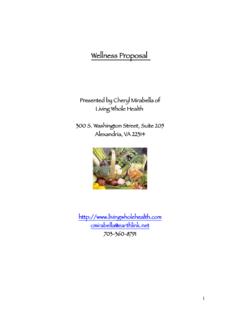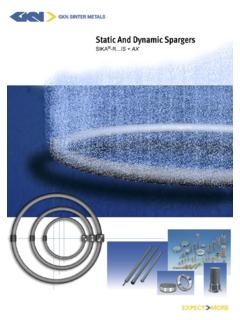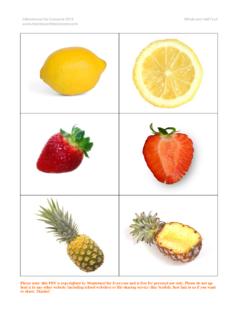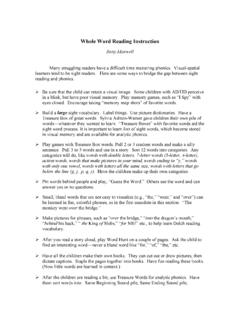Transcription of The Model of Whole-Person Caring
1 FEATURESThe Model of Whole-Person CaringCreating and Sustaining a Healing Environment Lucia Thornton, MSN, RN, AHN-BCAt Three Rivers Community Hospital, Grants Pass, Ore, the theoretical Model of Whole-Person Caring has resultedin quantifiable and sustainable results in the areas of increased patient and employee satisfaction and decreasednursing turnover, and serves as the foundation for a comprehensive healing environment. The Model is a usefulframework for healthcare education and its utilization as the theoretical construct for The New England School ofWhole-Health Education illustrates its congruency in an educational WORDS:energy-based care,interdisciplinary care,relationship-centered care,spiritual careHolist Nurs Pract2005;19(3):106 115 The Model of Whole-Person Caring (WPC)provides a framework for healthcare systems andorganizations wishing to create a healing andnurturing environment for consumers andhealthcare personnel.
2 This framework is derivedfrom theorists in the fields of nursing, physics,and systems analysis. The Model is unique inthat it is interdisciplinary, easy to understand,practical in its application, and redefines whowe are to embrace our infinite and spiritual is a Model born from experience, and hasdemonstrated the following quantifiable andsustainable results at Three Rivers CommunityHospital, Grants Pass, Ore: increased patient satisfaction increased employee satisfactionC Copyright Lucia Thornton, 2005. Portions of this article have previouslyappeared in articles co-copyrighted by Gold & Thornton, Inc, ISSSEEM,International Journal for Human Caring , Surgical Services Management,and Lucia author thanks Debra Topham, PhD, RN, CNS, ACRN, for conducting,analyzing, and creating the research report on the Integration of Organiza-tional Values After Participation in a Transformational Leadership Course.
3 Dr Topham, a clinical nurse specialist, can be contacted at Medicine CareCenter, United Hospital, 333 Smith Ave N, St. Paul, MN 55102 author: Lucia Thornton, MSN, RN, AHN-BC, 12592 ValleyVista Lane, Fresno, CA 93720 (e-mail: Press-Gainey Patient Satisfaction reports increased to 94% hospitalwideafter the Model was implemented. Prior to implementation, the average hos-pitalwide scores were in the low 80th percentiles. This report is based onnationwide statistics and represents each hospital s standing in relation tonational data. decreased nursing turnover below the nationalaverage increased integration of organizational values by em-ployees (see Appendix on Integration of Organiza-tional Values Research) enhanced healing environmentThe work accomplished at Three RiversCommunity Hospital has achieved recognition at boththe state and national level via the Fetzer Institute sNorman Cousins award in 2004 and the OregonAssociation of Hospitals and Health Systems Awardfor Professional Excellence in Healthcare OF THE Model OFWHOLE-PERSON CARINGThe Model of Whole-Person Caring was created whiledeveloping a curriculum for Three Rivers CommunityHospital.)
4 The purpose of the curriculum was to helpcreate a healing and nurturing environment for bothemployees and patients. The interdisciplinary coregroup enrolled in the leadership program consisted ofadministrators, managers, office staff, nurses,respiratory therapists, dieticians, aides, massagetherapists, and community members. Because of thegroup s diversity, it was important to develop aframework that created a common ground for all In 2001, after participants completed the Certificate Program in Transfor-mational Healthcare Leadership (the educational component for the Modelof Whole-Person Caring ), the RN turnover rate reached a low of 3% com-pared with a national average of 18% at the of Whole-Person Caring107practices and services that was practical, operational,easy to understand, and credible.
5 The efficacy of thismodel lies in its simplicity and ability to engageparticipants in a common vision and operationalizedconcepts that are inherent to healing. When alignedaround shared values and united in a common vision,ordinary people accomplish extraordinary of a visionary modelModels help define who we are, what we do,and how we do it. It is important for leaders inhealthcare to begin utilizing models that canfundamentally change how healthcare is delivered. Inthe last 3 decades, the healthcare industry has beendriven by business models that embrace thebiomedical perspective. Healthcare has becomeincreasingly unavailable to the greater population, andthe delivery of care is often characterized asfragmented and impersonal.
6 Creating a system that ismore accessible, less fragmented, and acknowledgesour wholeness is not the system first requires a paradigmaticshift in how we perceive ourselves. How we perceiveourselves and each other dynamically impacts how wecare for ourselves and care for each other. However, as physicists have concluded, the reality of who weare is too rich to be fully expressed in any Model best, this Model is a metaphor that can helpus come to a common understanding or sharedperspective of who we are. The Model , therefore, isnot meant to define the truth of our existence, since defining imposes limits on that which is definition is instead just a was intendedto begin to shift the healthcare community s perceptionTABLE Caring definitions8 TermDefinitionPersonAn energy field that is open, infinite, and spiritual in essence, and in continual mutual process withthe environment.
7 Each person manifests unique physical, mental, emotional, and social/relationalpatterns that are interrelated, inseparable, and continually energy field beyond and inclusive of the person. Because person and environment are in a stateof constant mutual process, there is no distinction from an energetic subjective experience of caringThe delivery of care and services to promote well-being. Whole-Person Caring is based on theconcepts of sacredness of being; therapeutic partnering; self-care and self-healing; optimalwhole-person nourishment; transformational health care leadership; and Caring as sacred spiritual dimension is a unifying field that integrates the physical, mental, emotional, andsocial/relational aspects of being.
8 The spiritual dimension is the essence of self and alsotranscends the self. It is our closest, most direct experience of the universal life who we are from being biomedical entities toinclude the sacred and infinite nature of our work of 3 nurse theorists formed thefoundation for defining who we are. FlorenceNightingale stated, We are a reflection of the divine,with physical, metaphysical, and intellectualattributes. 5 Martha Rogers saw each person as an irreducible, indivisible, pandimensional energy fieldthat is open and infinite in nature, and inseparablefrom the environment. 6 Jean Watson, a contemporarynurse theorist, states, We are sacred beings [and] wemust regard ourselves and others with deepest respect,dignity, mystery, and awe.
9 (J. Watson, personalcommunication, December 5, 1998).In the Model of Whole-Person Caring we define theperson as an energy field that is open, infinite, andspiritual in essence, and in continual mutual processwith the environment. Each person manifests uniquephysical, mental, emotional, and social/relationalpatterns that are interrelated, inseparable, andcontinually evolving (Table 1).In the Model our manifest self, which is representedas a diamond, arises from the unmanifest universe orthe void, as it is sometimes called. While there is acomplete absence of matter in this realm (hence, thevoid), its exquisiteness, omniscience, and fullness isoverwhelming. Rather than being called the void itmight be more likened to the womb of God.
10 Yogananda referred to this realm as the energy field emerges from the unmanifestedAbsolute or unmanifested universe. In the Model ofWhole-Person Caring , this energy field is also calledthe field of Love. For the purpose of this Model , thisenergy field is considered to be the first field of the108 HOLISTICNURSINGPRACTICE MAY/JUNE2005 FIGURE of universe. Everyone arises from this primalenergetic field; it is our common ground and sharedessence. Although these words fall short ofexpressing reality, they point us in the direction ofbeginning to understand the implications of ourinfinite nature. If we are open, infinite energy fieldsthen not only are we finite forms that exist on thisearth, but we simultaneously share in the essence ofthe unmanifested , not only do weoccupy and move about in our individual physicalspace, but we simultaneously exist in a unifiedcollective energy field with all metaphor of a diamond represents thewhole-person concept (Fig 1).






